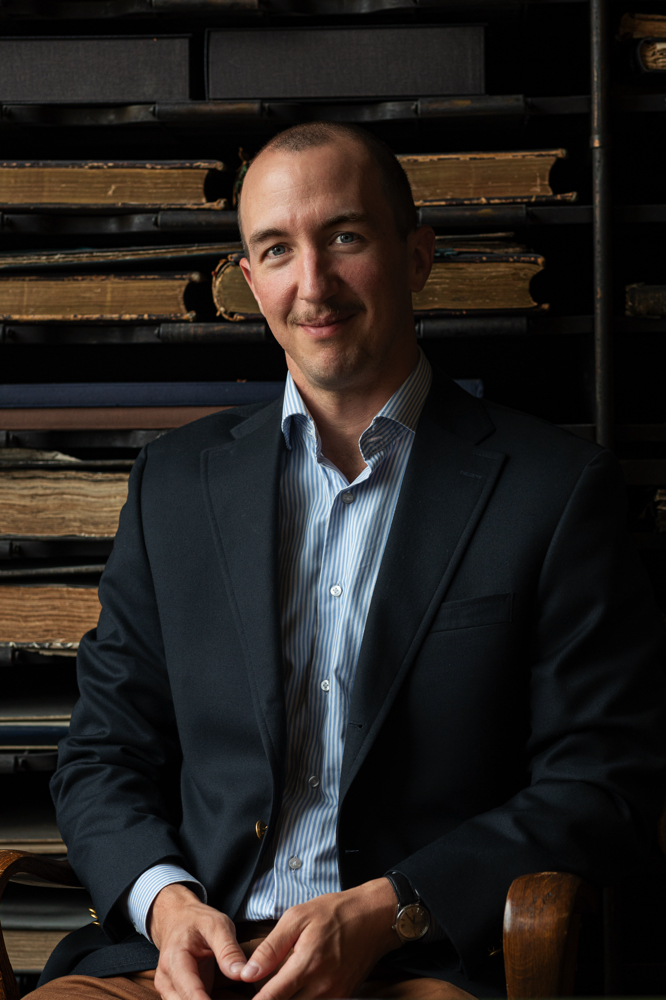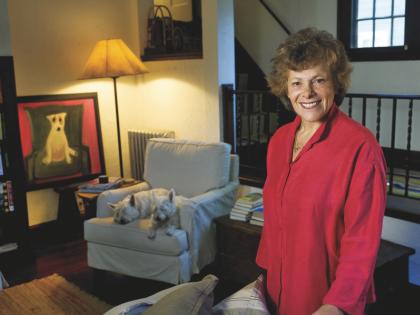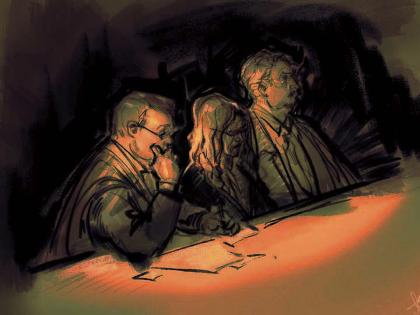It’s an all-too-familiar nightmare. After a smooth drive on a freeway, you pull into the city to run an errand, grab lunch, or drop your child off at school. But all the curb spots are taken, and the garage costs $25 an hour. So, you circle the block, searching for that precious free spot. Meanwhile, you’re slowing down traffic, burning fuel, and wasting time.
Paradoxically, argues 2023-24 Loeb Fellow Henry Grabar, reducing the stock of free parking on American streets can improve cities. The curb, he says, is one of a city’s most valuable assets. To allow people to park their cars there for free—often for extended periods—is a poor allocation of space, and a missed opportunity for urban improvement.

Henry Grabar
Photograph by Amy Elisabeth Spasoff
It’s easy to find anti-car screeds online. But the Slate journalist, who held the cross-disciplinary Richard Rogers Fellowship at the Graduate School of Design (GSD) in 2020, acknowledges that cars, per se, are not the issue. In a new book, Paved Paradise: How Parking Explains the World (Penguin Press), Grabar illustrates how Americans have saturated their cities with parking. Along the way, they have demonstrated that they often care more about housing cars than housing people. Grabar’s clear and humorous book, published in May, brings discussions of parking minimums and housing codes from backrooms to the dinner table.
Grabar has been writing for the Metropolis section at Slate since 2016. There, he focuses on housing, transportation, and the environment. This fall, he’ll be coming to campus for the GSD’s yearlong Loeb Fellowship.
Recently, Grabar discussed parking’s impact on urban design, Harvard’s role in parking studies, and his Harvard fellowships in an interview with Harvard Magazine, edited for length and clarity.
Harvard Magazine: How would you describe the book to people who haven’t yet read it?
Henry Grabar: My elevator pitch for the book is that it makes the case that we should begin to seriously consider parking as a feature of the urban landscape. That sounds like a pretty basic idea, but for much of the last century, we haven’t really given parking very much serious thought. It turns out that our interest in creating free and easy parking has prevented us from achieving many of our other goals in related fields like a sustainable environment, attractive architecture, affordable housing, walkable streets—all those things have been basically sacrificed on the altar of creating an easy place for everyone to park.
HM: Throughout the book, you validate the appeal of cars and proximal parking. Can you talk more about the contradiction between building free parking and making the city more accessible?
HG: Many people do think of parking, and in particular free parking, as being synonymous with access. In [some] places, that’s even enshrined in the law, like in Texas, where you can’t restrict parking on the beach unless you provide some alternate place for people to park. Because driving is the only way most people have of getting somewhere, parking is really for them almost synonymous with access. At the same time, parking has so many negative externalities that if you’re only thinking about it as providing access to people, you are, in the end, denying a more fundamental idea of access. Let me give you a really concrete example of that: parking drives up the cost of housing by 15 percent to 30 percent. That’s a pretty big tax you’re levying on every new unit that comes on the market, to provide parking. So yes, the parking that you’re providing functions as a kind of access, but a 30 percent tax on every new development is, in a more fundamental sense, denying people the right to access the city.
HM: Pedestrians and drivers are not really two separate groups—we can act as both. How do you recognize that people align with both the pedestrian and the driver?
HG: Everybody who drives is going to get out of their car sooner or later. But one of the ironies is that the more parking you provide, the less pleasant a neighborhood becomes to walk around in. That’s both because parking takes up physically a lot of space, so it spaces out the amenities, but also on a more experiential level, block by block, the experience of walking through a landscape that’s covered in parking lots is unpleasant. So, the effort to provide people with real onsite parking access actually takes away from the experience of being a pedestrian and, in turn, encourages people to seek to park as close as possible to their destinations. Nobody wants to walk three blocks through a strip mall on the side of the highway, but people are very happy to walk three blocks through Cambridge. You’re shooting yourself in the foot as you provide more and more parking.
HM: You frequently poked fun at the absurdity of America’s parking culture. How you were able to find a balance between your serious analysis and humorous interjections?
HG: Well, it’s not a very interesting subject for a lot of people, so I knew that I would have to keep people’s interest despite the fact that the entire book is about a lifeless plot of asphalt. Parking does lend itself to funny anecdotes because there is this inherent contrast in parking where it’s both incredibly banal and boring and also people do ridiculous things to get it. When you begin to think about it, most of us have done something kind of insane to get a parking spot.
HM: You shared that you once missed a beach day because you were circling for free parking. How do you separate the human interest in finding a spot from the systemic design flaws that lead us to look for one?
HG: I’m not immune—I don’t like paying for parking either. Now that I’ve written this book, I can recognize that there are many negative externalities associated with free parking in busy locations. But that doesn’t mean I love to put money in the meter.
A lot of cities think of parking as a cash cow, a way to raise money for the general fund. Don Shoup, who is the godfather of parking studies today, would say that if you want people to get behind parking meters as a concept, you need to be very explicit that that money is going towards local improvements. Yes, they’re paying $5 to park while they go about their business, but that parking money is what pays for benches and street trees and tulips and clean streets. They may not like paying for parking, but at least they can understand that the money they’re putting in the meter goes towards something they appreciate.
HM: You tell the story of Chicago selling its parking meters to a private equity firm. How is the design of a city affected when it loses control of its curbs?
HG: It forecloses any possibility of returning to the diversity of uses that characterized the curb for most of human history and certainly in 19th-century and early 20th-century American cities. Especially post-COVID, you’re seeing a lot of cities looking at their streets and saying, ‘These are some of our most important and valuable assets, and we have been dedicating them for 100 years just to the free storage of private automobiles. What if we did something else?’Maybe we should have a zone for trucks to do deliveries. Maybe this is where we should put the bike lane. Then you can go further still. You can say, maybe this curb space should be public space, maybe it should be seating areas. That becomes impossible when you no longer control the right to the curb.
Going forward, green space will become more important. Cities are increasingly dealing with the challenge of extreme heat and extreme rainfall. Each of those issues is exacerbated by the amount of impervious heat-retaining and -emitting asphalt and concrete. You’re seeing cities begin to recognize that, if we’re going to address these twin climate change issues, this undervalued strip of asphalt adjacent to the sidewalk is a great place to start thinking about making cities greener.
HM: How does your experience living in both Europe and the United States inform your understanding of parking?
HG: I’m always hesitant to try and draw too many analogies because Europe is in such a different place with respect to the quality of mass transit and the density of housing. A lot of the time in the U.S., we’ve become so accustomed to the idea that every block needs to be dedicated to car storage that, when it comes time to suggest that a block could simply be open public space, people come to it with really high expectations. In Paris, they don’t really seem to think that hard about it. They just close streets and then they see what happens. If just two or three people are walking up and down and enjoying a quiet car-free street, I don’t think that people in Paris look at that as a waste of space—‘we used to park our cars there.’ In America, whenever anybody sees a bike lane that doesn’t have 35 people riding bikes in it, they look at it and say, ‘what a waste of space.’ I think that’s something that we should try and get over.
HM: You briefly mention Harvard’s Bureau for Street Traffic Research, a 1920s program funded by the auto industry. In your book, you write they found that “curbside parking reduced the capacity of a typical downtown street by 30 to 50 percent.” What did you learn about this group, and what does it tell us about modern parking studies?
HG: The Harvard Bureau for Street Traffic Research was a creation of Miller McClintock, who was one of the early thinkers about this subject. Don Shoup [leading parking researcher and professor of urban studies at the University of California, Los Angeles] has basically single-handedly created interest in this subject for most people who study parking today. However, in early twentieth-century America, there were a lot of people who were really interested in this idea, and who saw parking as a complicated system that needed to be managed correctly. And if it wasn’t managed correctly—including by letting people park for free for unlimited amounts of time—you were going to end up with a very bad situation where the entire city would be taken over by parked cars. This Harvard Bureau was indicative of the level of interest devoted to this subject.
HM: You wrote this book sandwiched by two Harvard fellowships. In 2020, you were part of the Richard Rogers Fellowship, and now you’re returning as part of the Loeb Fellowship. Could you tell me more about those GSD programs?
HG: The concept of the Richard Rogers Fellowship is to submit a research project based in London. I had been interested in London as part of my parking research because London was one of the first and largest cities to do away with parking minimums [associated with new construction]. It happened in the midst of a massive building boom, so you had this perfect natural experiment. All this housing was built with a required amount of parking up until this point, and then after that point, an equal amount of housing was built without those restrictions. A research paper about this found that, after the parking minimums were repealed in London, developers, predictably, built a whole lot less parking. Suddenly, instead of requiring all this parking, the city encouraged developers to do whatever they think the market demands. I wondered, what happened in the neighborhoods where those places were built? Were they overrun with people parking on the street and double parking and fighting each other over parking? Or were they full of households who had decided to own fewer cars and drive less? I never figured out the answer to that question because the travel portion of the fellowship was canceled because of COVID.
With just a couple of weeks to go until I arrive in Cambridge, I’m hopeful that this next Harvard fellowship, the Loeb Fellowship, will not be canceled because of COVID. More seriously, the Loeb is an opportunity to take time away from my day job as a journalist and to take a moment to really seriously engage with both classes and the network of people who are thinking about these issues, both at Harvard and at MIT. One of the great privileges of being a journalist is that you’re able to call up an extraordinary number of people in the world and just say, ‘Hey, can I talk to you for half an hour about your work?’ But, as a journalist, people sometimes don’t tell you exactly how they’re feeling because they don’t want it to appear in print. I’m excited to be able to have these conversations with people without the idea that the conversation is going to wind up in print.
HM: Is there a path forward for American cities, or have we really built ourselves into a corner?
HG: I have a lot of optimism about the future of the American city, and it stems from the fact that we have a tremendous housing shortage in this country. The estimates are that we’re about 4 million homes short. One of the principal problems with making American cities more livable, walkable, and bikeable is that so many places are relatively low-density and suburban, and we only have so many relatively dense neighborhoods that were built before the arrival of the automobile and the implementation of parking minimums. If you begin to think about where those 4 million homes are going to go, suddenly, you’re looking at the potential to take neighborhoods that were designed to be mostly single-family homes for nuclear families that are really dependent on cars, and you can begin to think about transforming them and seeing them grow in density to the point where they actually have enough residents in a given square mile to support more walkable amenities.
You’re seeing it even now in places like Los Angeles, famously a city where nobody walks, supposedly. It’s, by some measures, the densest metro area in the United States. Now, the state of California has effectively abolished single-family home zoning by telling everybody that they’re able to build an accessory dwelling unit on their lot. In LA, the density of these neighborhoods in terms of households per square mile could double as everyone begins to build out another dwelling unit on their lot. That, to me, is an example of the type of change that could happen in the coming decades, and could make it possible for us to trigger that virtuous cycle, where a neighborhood formerly dependent on cars begins to grow denser and, as it grows denser, acquires the density of amenities and schools and restaurants and shops and parks that make it a complete place so that people don’t feel like they have to get in the car every day.








